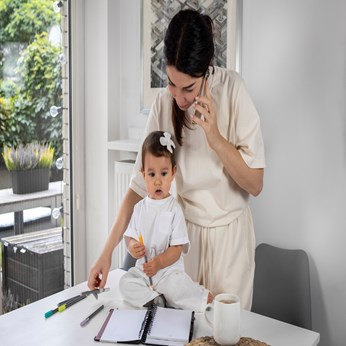Swimming with your child - What to do and what not to do
I am sure you would love to let your child experience the fun of water; though it may seem like an expedition, it is worth the trouble as it not only helps improve the confidence of the baby, but also helps him/her to tire out and get good quality sleep. Water could be a positive experience for the child when we as parents know what to do and what to avoid with the baby.
All about the dos and don’ts of the swimming experience:
Let the baby experience the pleasure of water before being introduced to the pool; start off by taking a bath with him/her, allowing the baby to feel the trickling running water over him/her. Ensure that you maintain eye contact and smile and laugh as you do so.
Start the swimming experience as early as possible as there is no need to be immunized; get them to the pool when you feel ready. Making the swimming trip a stress-free experience involves your putting on your swimming costume under your clothes before heading out; this helps focus on the baby while at the pool.

Remember to always put a swim nappy on your little one before entering the pool; they are required at public pools, and a good idea for the home pool as well. Ensure the nappy is made of absorbent materials that do not swell in the water and have unique leak guards and easy open sides that not only help avoid little accidents, but also make change time as hassle-free as possible.
Swimming, getting used to water and enjoying is something new for the baby; while some may take easily to water, others may act cautious and unsure. If your child does not hesitate, gently take him/her into water holding one tight and dip the toes into water to help them connect the fun water of the bath with the water in the pool; if they are happy, smile and laugh, splash some more water. Have patience with a baby that is hesitant; let someone bring him/her to the pool area and allow one to look around when you are in the water splashing around. Slowly but gradually the child will show interest in the pool, smile and look positive; he/she can be taken closer to the pool as one cooperates.
Stay close to the little one always; it is not only safe, but also helps develop a close bond with him/her. Ensure that you maintain eye contact with the baby, relaxing and dropping down to the same level; then your baby will love seeing you splash water. When the baby is smiling and in your arms making big splashes, it is the time when the gradual introduction to the fun of the pool pays off.
Avoid using the pool between 10 AM and 4 PM to avoid exposure to sun and the ultraviolet rays. Use long sleeved clothing to keep the baby safe from the sun.
You can join swimming classes when your child is about 3-4 months, though formal swimming lessons start when the child is 3 to 4 years; these early experiences with other babies and their mother in the pool filled with lot of laughter, smiles and splashing help reinforce the positive nature of being in the water.
Ensure that you lay the baby safely on the poolside, then enter the water and then lift the baby in; ensure hygiene and safety to the little one by avoiding trips or falls with using durable non-slip little swimmers mats that are available in various attractive designs.
That’s to the dos and don’ts of swimming with your child.
Image Courtesy: Google
Take the next step toward your goals
Share your requirement and find the best care providers in your area
-
Looking for a caretaker’s job? Build your profile and get in touch with families in your vicinity.
-
Discover nannies, babysitters, cooks, housekeepers, pet sitters, and elder care under one roof.
-
Get all the support you need to run a successful care center.
-
Search for appropriate centers near you depending on your needs.
Care Corner Insights: Blog Library

Deep Cleaning Your House: Room-by-Room Checklist for a Thorough Clean
A sparkling clean home isn’t just about looks—it’s about health, comfort, and peace of mind. Whether you’re prepping for a festival, hosting guests, or just tired of the clutter, a deep clean can transform your space. But where do you start? Here’s a

What are Senior Apartments? Experts Explain Independent Living for Older Adults
As we age, our needs and lifestyles evolve—but one thing remains constant: the desire for independence. Senior apartments are designed precisely with this in mind, offering older adults a living arrangement that balances freedom with comfort, safety,

Baby Sleep Problems: What is Sleep Regression and How to Handle It
If you’re a parent, you know that baby sleep is one of the greatest mysteries of life. One day your little one is snoozing like an angel, and the next day they’re suddenly waking up every hour, fussing, or refusing to nap. Before you panic, there’s a

Daycare Admissions in Cary, NC for New NRI Families: Documents, Health Records, and Start Dates
Moving to a new country is exciting but also comes with many responsibilities—especially when it comes to finding the right daycare for your little one. For new NRI (Non-Resident Indian) families settling in Cary, NC, understanding the daycare

Overnight Babysitters in Bellevue, WA for Business-Travelling NRI Parents: Safety & Policies
For many NRI parents living in Bellevue, WA, frequent business trips are a reality. While traveling, one of the biggest concerns is ensuring your children are safe, cared for, and emotionally supported during overnight stays. Overnight babysitters ca

Indian Home-Style Cooks in Queens, NY: Tiffin-Style Weekly Meal Prep from Your Kitchen
Queens, NY, is home to one of the most diverse food cultures in the country, and Indian cuisine holds a special place among families looking for authentic, comforting meals. While restaurant takeout is convenient, nothing compares to the taste and nu

Baby Sleep Problems: What is Sleep Regression and How to Handle It
If you’re a parent, you know that baby sleep is one of the greatest mysteries of life. One day your little one is snoozing like an angel, and the next day they’re suddenly waking up every hour, fussing, or refusing to nap. Before you panic, there’s a

What is Validation Therapy? A New Approach to Dementia Care
Caring for loved ones with dementia is one of the most emotionally challenging journeys a family can face. Traditional methods often focus on correcting memory lapses or redirecting confused thoughts—but that can sometimes lead to frustration, stress

What is a Part-Time Nanny and Do You Need One
Parenting is a beautiful journey, but let’s be honest—it can also be exhausting! Between work deadlines, household chores, and family responsibilities, sometimes there just aren’t enough hours in a day. That’s where part-time nannies step in, offerin

Part-Time Housekeeper Hiring in Alpharetta, GA: Weekly Schedules, Pricing, and Must-Do Tasks
Keeping a home spotless while balancing work, family, and personal commitments can be overwhelming. For families and professionals in Alpharetta, GA, hiring a part-time housekeeper is one of the most practical solutions. Whether you need help once a